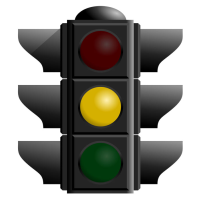Los Angeles Is World’s First Major City to Sync up All of Its Traffic Signals

The typical Los Angeles metropolitan commuter wasted $1,300 last year while stuck in traffic for an extra 61 hours, probably wondering how much worse it could get.
Now, that statistically average driver will have a few minutes less to think about it since the famously gridlocked city became, reportedly, the first major metropolis in the world to synchronize every one of its traffic lights located within its 469 square miles. By adjusting the length of L.A.’s 4,500 signals based on traffic flow, its road warriors should spend less time traversing its vast network of roads.
The Los Angeles metropolitan area (including Long Beach and Santa Ana) has the second-worst per-commuter gridlock problem in the nation (behind Washington DC), according to the annual Urban Mobility Report from Texas A&M Transportation Institute. Congestion cost the country $121 billion in 2011, up from $94 billion in 2000, based on wasted fuel, lost productivity, medical expenses caused by pollution and other problems, delayed truck deliveries and other reasons.
But after 30 years of synching traffic lights, at a cost of $400 million, the Los Angeles Transportation Department claims that the average speed on its streets has increased 16%, while delays at major intersections are down 12%.
So now, instead of crawling along at 15 mph, a driver can crawl along at 17.3 mph. Less idling in traffic should also cause a reduction in carbon emissions.
The Automated Traffic Surveillance & Control system, first proposed as a way to ease congestion before the 1984 Summer Olympics in L.A., didn’t really kick into high gear until 2006 when voters approved spending $150 million to complete it. As the name implies, the computerized system is fully automated to utilize sensors and cameras around the city, although it can be overridden by traffic engineers seeking to tweak the flow.
The situation has gotten much worse in the interim. L.A. drivers sat in gridlock in 1982 an average 37 hours more than they would have if traffic moved at posted speeds. That number climbed to 72 in 2000 and peaked at 78 in 2005. It crept back down to 61 hours by 2010, but the decline was heavily influenced by unemployed former workers driving less in a decimated economy.
Synchronized traffic signals have been heavily touted by municipal officials across the country for years. The system is not so much a magic bullet, as perhaps the only bullet left in the chamber. Most big cities have built out their freeway systems, can’t afford to build more if they wanted to, or don’t know how—or can’t afford—to construct workable mass transit systems. All of that applies to Los Angeles, which is also taking the first steps toward congestion pricing, a controversial scheme to convert carpool lanes into toll lanes for single drivers willing to pony up extra money to drive faster.
-Ken Broder
To Learn More:
To Fight Gridlock, a City Synchronizes Every Red Light (by Ian Lovett, New York Times)
Los Angeles Becomes First City in the World to Sync Every Traffic Signal (Thinking Highways)
Revenue Opportunity: Shortening Yellow Traffic Lights (by Noel Brinkerhoff, AllGov)
Terrorized Drivers in L.A. Need 60-Day Carmageddon II Warning (by Ken Broder, AllGov)
Urban Mobility Report (Texas A&M Transportation Institute) (pdf)
- Top Stories
- Unusual News
- Where is the Money Going?
- Controversies
- U.S. and the World
- Appointments and Resignations
- Latest News
- Trump Announces He Will Switch Support from Russia to Ukraine
- Americans are Unhappy with the Direction of the Country…What’s New?
- Can Biden Murder Trump and Get Away With it?
- Electoral Advice for the Democratic and Republican Parties
- U.S. Ambassador to Greece: Who is George Tsunis?






Comments